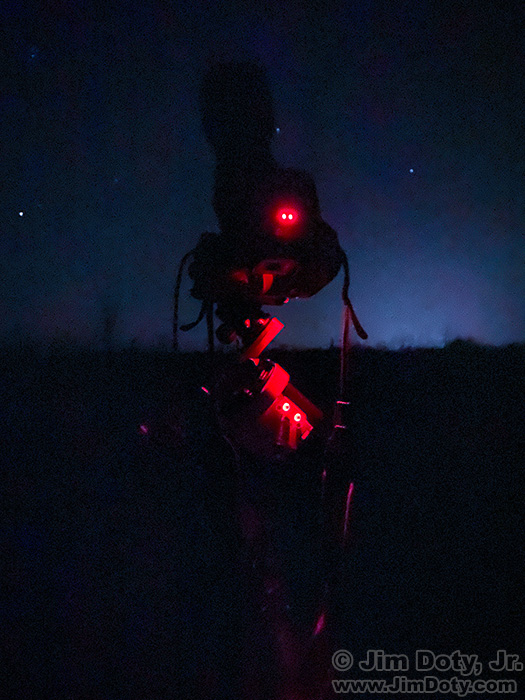
With a tripod mounted camera and a 300-400mm telephoto lens, it is possible to photograph Jupiter and its four Galilean moons (they are named for Galileo), and Saturn and its biggest moon, Titan. I captured them during their Great Conjunction a little over two years ago. Jupiter is on the left with three of its Galilean moons. Saturn is on the right and Titan is just to the right of Saturn.
Here’s a closer look with an insert from the software Stellarium, which is a free download. Jupiter’s moons from top to bottom are Callisto, Io, Ganymede (which is not visible in my photo due to being lost in Jupiter’s glow), and Europa. To the right of Jupiter are Saturn and Titan. Saturn’s second biggest moon, Rhea, is not visible in my photo.
I used a Canon 7D Mark II camera and a Canon 100-400mm zoom lens. The lens aperture was f/6.3, the shutter speed was 5 seconds and the ISO was set to 6400.
The camera and lens were mounted on a Sky-Watcher clock drive which is how I was able to use a 5 second shutter speed without Jupiter, Saturn, the moons and stars turning into streaks of light. If you aren’t using a clock drive that follows the movement of the stars, you will need to use a faster shutter speed.

This is my image of the recent Great Conjunction of Jupiter and Venus. Three of Jupiter’s Galilean moons are visible.

Here’s the Stellarium view with the names of the three Galilean moons that were visible that night. Stellarium usually shows you a larger area of the sky, but you can zoom in on Jupiter and Saturn to see their moons.
When you aren’t using a clock drive, with a telephoto lens around 300-400mm you should not use a shutter speed longer than 1 second. For this March 1 photo, I used a Canon 7D Mark II camera and Canon EF 100-400mm lens but NO clock drive. The lens aperture was f/8, the shutter speed was 1 second, and the ISO set to 3200.
Focusing can be an issue and autofocus is not reliable. Turn off autofocus and if your lens has image stabilization, turn that off too. Manually focus the lens at infinity. Look through the viewfinder and center Jupiter in the frame. Focus as best you can to make Jupiter look as small (i.e. sharply focused) as possible in the viewfinder. If your camera has it, turn on “live view” mode so Jupiter shows up on the LCD on the back of your camera. Zoom in to 10X magnification and focus again on Jupiter and the moons. For details on how to use live view focusing with a magnified image, read the article at the link below.
To get an image like the March 1, 2023 photo, you will need to crop in to the center of the image. The amount of cropping will depend on how long your telephoto lens is. Experiment with the exposure. 1 second at f/8 at ISO 3200 is a good starting point. Try other shutter speeds (but no longer than 1 second) and different ISO settings. Use your camera’s 2 second delay so your camera has 2 seconds to settle down after you push the shutter button. If you have mirror lock up, use it. If your camera is in live view mode, the mirror is already up, another advantage of live view mode. Using a cable release with the 2 second delay is even better.
Link
How To Get Critical Focus in “Live View” Mode with a Magnified Image


